A U.N.-led call for action to tighten sulfur oxide emissions may also be a trigger accelerating a shift to natural gas as fuel for the global shipping fleet, and Japan is wasting no time trying to establish a refueling hub in Asia.
Some 80,000 vessels worldwide are weighing how to comply with the International Maritime Organization's new requirements to cut sulfur emissions that take effect Jan. 1. Though the vast majority will likely shift to low-sulphur fuel oil, a growing number of vessels are turning to sulfur-free liquefied natural gas (LNG) amid heightened calls for curbing emissions.
To spur new demand for LNG bunkering, Japan is subsidizing projects in a rush to build vessels that make ship-to-ship LNG supply possible. Though some places including Yokohama allow supply of LNG to ships via trucks and pipelines on shore, LNG-powered ships usually refuel when they stop at ports for unloading or loading goods, making it necessary to build LNG supply vessels.



















With your current subscription plan you can comment on stories. However, before writing your first comment, please create a display name in the Profile section of your subscriber account page.